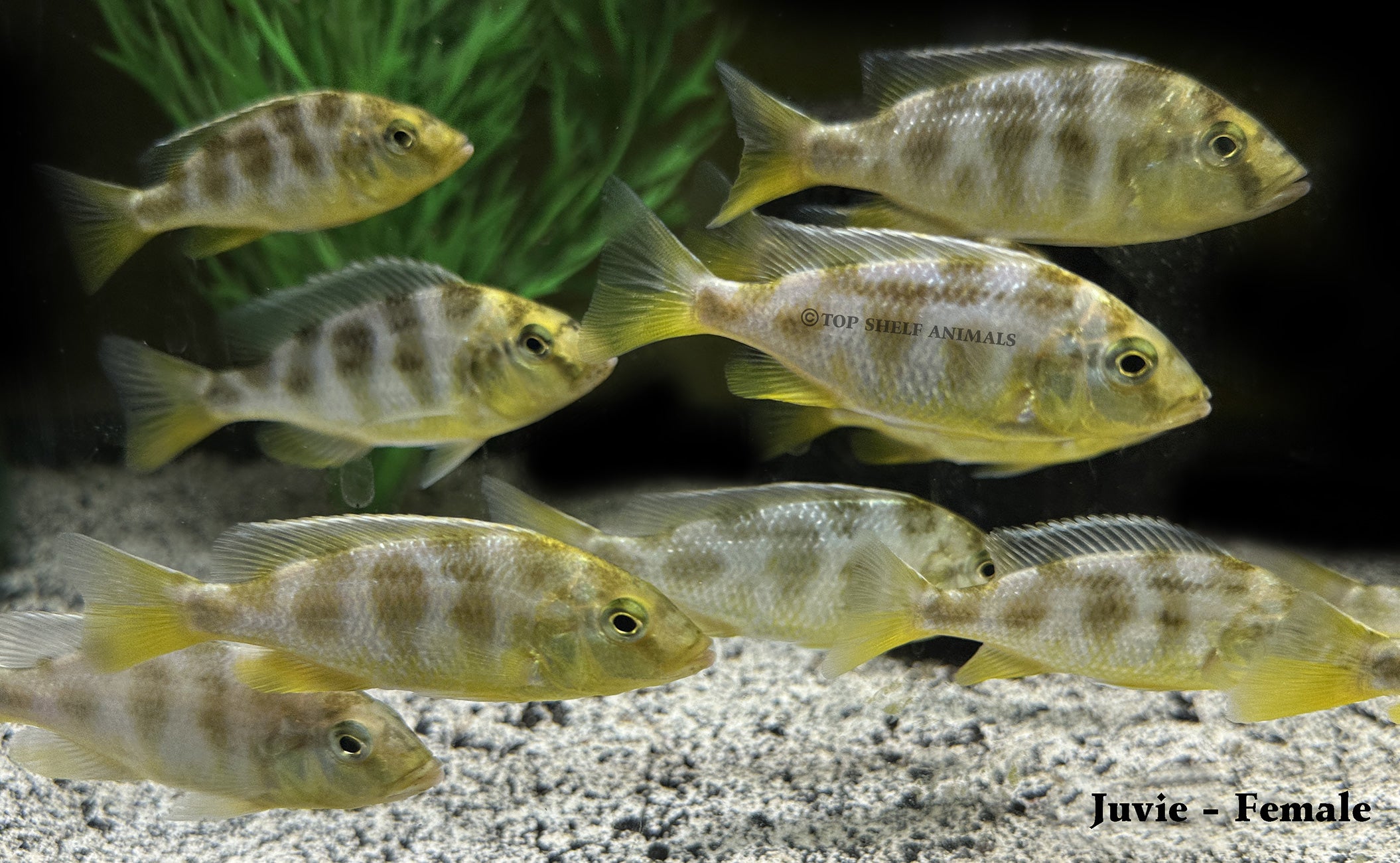Step 1: Inspect the Fish
- Action: Before opening the bag, carefully inspect the fish inside.
- Note: If you notice any issues or have concerns, leave the bag sealed and refer to our shipping policy for further instructions.
Step 2: Float the Bag
- Action: Place the sealed bag containing the fish into the top of your aquarium.
- Purpose: This allows the water temperature in the bag to gradually adjust to the temperature of the aquarium.
Step 3: Wait 20-30 Minutes
- Action: Leave the sealed bag floating in the aquarium for 20-30 minutes.
- Purpose: This waiting period ensures that the fish acclimate to the new temperature, reducing stress and shock.
Step 4: Transfer the Fish
- Action: After the waiting period, gently open the bag and use a net to carefully strain the fish over a bucket. Dispose of the bag water and avoid introducing it into your aquarium.
- Purpose: This prevents any potential contaminants or differences in water chemistry from entering your tank.
Step 5: Place Fish into Tank
- Action: Carefully place the fish into your aquarium using the net. Keep the aquarium lights off for 24 hours.
- Purpose: Keeping the lights off helps the fish to acclimate to their new environment with minimal stress. Do not feed the fish until the following day.
What Does Cycling an Aquarium Mean?
Cycling is a process used to cultivate beneficial bacteria in your aquarium that consume harmful fish waste, also known as the Nitrogen Cycle. Without these bacteria, keeping fish in an aquarium would be challenging. There are two main methods for cycling an aquarium: Fish-In Cycling and Fishless Cycling.
Fish-In Cycling
Fish-In Cycling involves adding fish to the aquarium shortly after setup. The waste produced by these initial fish helps to grow the beneficial bacteria needed to make the tank safe for other inhabitants. This method can be simpler for some hobbyists but requires careful monitoring to ensure fish safety. Fish-In Cycling generally takes 4-8 weeks, but bacteria supplements like Fritz 7 or Microbe-Lift Special Blend can speed up the process.
Steps for Fish-In Cycling:
- Set up your aquarium and add a water conditioner. Ensure all equipment (filters, heaters, etc.) is operational.
- Wait 7 days.
- Add a few hardy cichlids and dose with a bacteria supplement such as Fritz 7 or Microbe-Lift Special Blend. The number of fish should depend on tank size and fish size; typically, 3 smaller cichlids or 1 larger one is recommended.
- Feed fish every other day to limit waste production. Increase feeding frequency only after the tank is cycled.
- Test water levels every 2-3 days for ammonia and nitrite. Ammonia and nitrite levels should rise and then fall as bacteria establish. Avoid allowing ammonia and nitrite levels to exceed 0.5-1 ppm. If they do, perform a 15-30% water change and add more bacteria starter.
- Conduct a minimum of one 20-30% water change per week. Always use a water conditioner when adding water.
- Continue monitoring until ammonia and nitrite levels drop to 0 and nitrate levels are present. The tank is now cycled and ready for additional fish. Add fish gradually, in groups of 3 or so every few weeks. Continue to add bacteria supplements if desired.
- Maintain water changes to keep nitrate levels under 40 ppm, with 30%-50% weekly water changes as a standard practice.
Fishless Cycling
Fishless Cycling involves cycling the tank without fish by introducing a waste source to feed the bacteria. This method is safer for the fish, as it avoids exposing them to toxic ammonia and nitrite levels, and usually requires fewer water changes during the cycling process. It’s more complex and requires patience.
Steps for Fishless Cycling:
- Set up your aquarium with all equipment running and dechlorinate the water. Wait 24 hours.
- Add a bacteria starter like Fritz 7 or Microbe-Lift Special Blend.
- Introduce an ammonia source (ammonium chloride or other waste source such as fish food). If using fish food, add a pinch or half a spoonful of pellets. Let it decompose in the water.
- Test water levels, aiming for an ammonia concentration of about 3 ppm. Adjust as needed.
- Test water levels every other day for pH, ammonia, nitrite, and nitrate. Add more ammonia if levels drop below 2 ppm, using a reduced dosage as needed. Avoid adding ammonia if levels exceed 4 ppm. Perform a 20-30% water change if pH drops below 7, without disturbing the substrate.
- As ammonia levels rise, bacteria will convert it to nitrite, which will then be converted to nitrate. When both ammonia and nitrite levels are consistently at 0 ppm and nitrate is present, the tank is cycled.
- Add ammonia to the tank; it should be processed within 24 hours. Stop adding ammonia once this is achieved.
- Lower nitrate levels through regular water changes. Keep nitrate levels under 50 ppm with 30% weekly water changes.
- Add fish gradually, in groups of 3 or so every few weeks. Consider adding bacteria supplements after adding new fish.
Common Mistakes When Cycling:
- Performing too frequent water changes to keep ammonia at 0 or using ammonia removers. Some ammonia is needed to feed the bacteria.
- Incorrectly measuring ammonia sources. Adjust based on the method used.
- Overstocking the tank too soon. Patience is key.
Once your tank is cycled, continue regular water changes to manage nitrate levels. Perform monthly filter maintenance and test water regularly, ideally once a week or as needed.
Malawi Cichlids typically require a larger tank to accommodate their size and territorial behavior. A minimum of 75-100 gallons is often recommended for a group.
The vibrancy of Cichlids can be influenced by several factors:
- Species and Gender: Some species naturally have more vibrant colours, especially males, who often display brighter hues to attract mates or establish dominance.
- Diet: A nutritious diet rich in color-enhancing foods, such as those containing carotenoids (found in shrimp, krill, and spirulina), can enhance the vibrancy of cichlids. We feed and suggest Northfin and Repashy
- Tank Hierarchy and Stress Levels: Dominant fish often display more vibrant colors to assert their position in the tank. Conversely, subordinate or stressed fish may have duller colors as a sign of submission.
- Water Quality: Poor water quality can stress fish, leading to faded colors. Regular water changes and maintaining proper pH, hardness, and temperature are crucial for vibrant coloration.
- Lighting: Proper lighting can make colors appear more vibrant. However, too much light can cause stress, so it's essential to find a balance.
- Age and Maturity: Younger fish may not yet have developed their full color potential. As they mature, their colors often become more intense.
Monitoring these factors can help ensure that all your Malawi Cichlids display their best colors.
They generally prefer water temperatures between 74-80°F and a pH of 7.5-8.5. Here at Top Shelf Animals we keep our tanks at 76-77 and Ph 7.9-8.1
They should be fed a varied diet, including high-quality pellets, flakes, and occasional frozen foods. Feeding 1 -2 times a day.
We suggests for adults to feed once a day and for younger fish 2-3 times a day.
Best way to raise ph is using crushed coral sand (as a substrate or in filter) or cichlid sands (that contain crushed coral) Or use a buffer such as Malawi or Tanganyika Buffer

